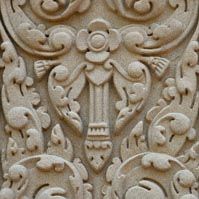
The German Ankorian Imagery Project
• G • A • I • P •
"Tevoda" is a Khmer word derived from Sanskrit "Devata", but with a slightly different meaning. A Devata is a female protecting semi-deity. A Tevoda is an asexual heavenly being, a kind of angel neither male nor female. The first syllable "Te" is slightly stressed. There are countless other transcriptions for "Chau Say Tevoda", for example "Chau Srey Tevoda" or "Chao Sai Tevoda".
The flat temple Chau Say Tevoda is located just south of the similar Thommanon Temple at Angkor's Small Circuit Road, 500 metres east of Angkor Thom's Victory Gate. It is linked to the nearby Siem Reap river by a sacred avenue, which is a later addition from the 13th century. A cruciform terrace with serpent-body balustrades is the eastern entrance platform to the temple.
The 42 metres long and 33 metres wide temple wall made of laterite has four Gopuram gateways in the cardinal directions. Gopurams and the other monuments are built from sandstone blocks. Two depictions of Ramayana scenes, including the death of Valin, at the south side of the east Gopuram, are in a sound condition. The causeway connecting the Gopuram with the main shrine again is a later addition from the time of Jayavarman VIII (1243-95).
There are two edifices called libraries in the north-east and south-east corner of the enclosed temple compound. The central main structure is a cruciform Prasat temple tower with a single Mandapa antechamber to the east. It is slightly smaller than the neighbouring Thommanon sanctuary. The sculptural decoration is of the same artistic quality, but in a poorer condition due to vandalism. The exterior wall of the Mandapa is covered with a floral pattern inscribed in geometrical squares and decorated with stone flowers similar to the famous stone carvings of Banteay Srei. A panel on the ground to the south possibly is an illustration of a maternity hospital.
The inscription of this temple tells us about a cermony called Shivasaharatri celebrated inside this temple. Shivasaharatri memorizes the night when Shiva made love with his nine wives to absorb female energy called Shakti, he thereby increased his sprititual energy to create the universe and all creatures. After completing his creation work Shiva died on his wife’s chest. Shiva's Linga and his wife’s Yoni symbolize this creational power. Brahmins poured water or milk on the top of the Linga, and afterwards collected the holy liquid from the spout of the Yoni panel.
Chau Say Tevoda was a syncretistic Hindu and Buddhist temple, as there are not only Hindu topics depicted in the lintels' and pediments' stone carvings, but Buddhist legends, too, the popular story of Preah Visadatara in particular. Some Buddhist reliefs at pediments were thoroughly scratched out during the iconoclasm period in the late 13th century. That's why Glaize calls the temple "Brahmanic" (Hindu). But the pediment at the west face of the southern satellite building marks the temple Buddhist.
Chau Say Tevoda was built in the Ta Som style in the middle of the 12th century, it is a few decades younger than the nearby Thommanon temple. From 2000 to 2009 Chau Say Tevoda was restored by a Chinese team, sponsored by the government of the People's Republic of China. In late 2009 it was reopened and now is fully accessible for the public.
There is no specific time of the day most recommendable for a visit of this temple.
Ernst Ando Sundermann
• G • A • I • P •
Copyright © 2021 khmer-heritage.de